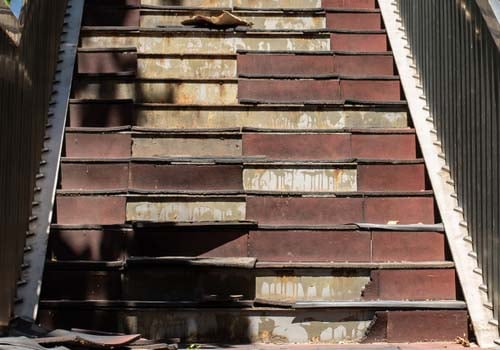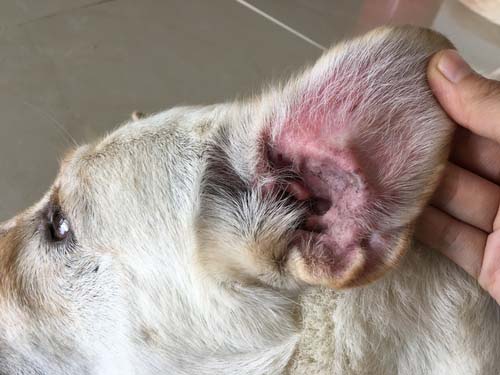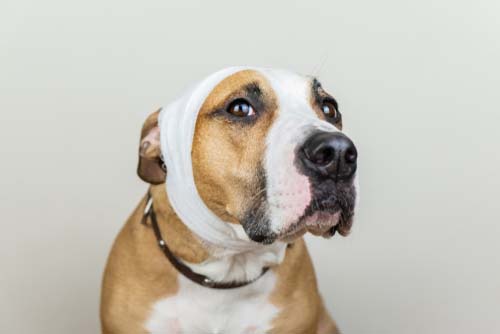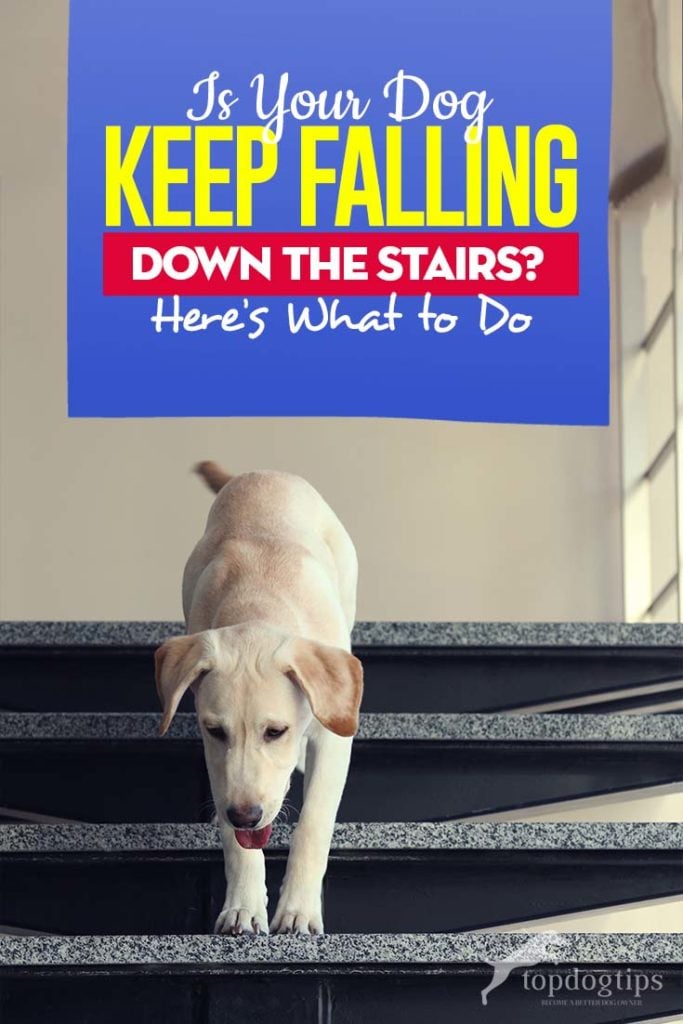
Table of Contents
Dogs are very well-coordinated animals that don’t lose their balance as easily as, for example, very young kids.
If you've been noticing your dog falling down the stairs recently, this could be just an accident caused by the design of the staircase, or it may be a health issue in the dog.
According to VCA Animal Hospitals, some injuries are visible immediately, while others may not appear for several days or hours after the accident.
Even if you don't see your woofer fall, you should be wary if you detect any of the following signs:
- whining
- lethargy
- limping
- stiff gait
- difficulty breathing
- reluctance to stand or walk
- pain when lying down or rising
- decreased appetite or difficulty apprehending food
Noticing the Dog's Fall from the Stairs
As a dog owner, you are used to hearing different noises around the house when your dog is playing, jumping, running, and attracting your attention.
If your dog likes to go up and down the stairs while you watch the TV in the living room, you may disregard the strange sound of bumping.
After you hear this more than once when your pooch is playing around the staircase, approach your dog immediately after you hear the bump and examine the dog's behavior and body.
Your dog cannot tell you if they're afraid, hurt, or confused.
Examine a dog's outer appearance by moving around the fur to check if there are any bruises, cuts, or lacerations, as these are the clear consequences of suffering a fall from the stairs.
Don’t be surprised if your pup looks confused, or even barking, or trembling, because these are common signs of shock, surprise, or fear.
If there is something wrong with your dog’s inner ear, they will not be able to understand that.
The most serious consequence of a fall from the stairs is a head injury, which is sometimes the most difficult to notice.
If there is blood on your dog’s head, this can be the consequence of a skull fracture caused by rolling down the stairs.
Also, if your pooch seems disoriented and is limping or losing consciousness, this can be caused by a concussion or other type of brain injury, which proves that your dog fell down the stairs.
Why Is Your Dog Falling Down the Stairs?
There could be several reasons why your dog is falling down the stairs.
While most commonly, it's benign in nature, sometimes this can be a rather serious problem that requires your immediate attention.
1. Staircase Design
The most benign reason, which shouldn’t be undermined, is that the stairs are not properly designed for your pet to go up and down.
Many materials used for regular staircases in houses, often popular in modern interior designs, such as hardwood or tiles, are too slippery for dogs.
If you have a small breed dog in your household and very high or steep stairs, it can be difficult for them to climb the staircase. That doesn’t mean that the dog won’t try to go upstairs anyway.
Broken stairs somewhere along the staircase or a piece missing from them are also common causes of dogs falling down the stairs.
2. Inner Ear Issues
Health issues may be the reason your pooch cannot properly navigate the stairs, too.
The cause of the fall can be any damage or injury to your dog’s inner ear, which regulates balance.
Additionally, the dysfunction of the dog's inner ear itself can be caused by different reasons, such as vestibular disease.
You may notice inner ear dysfunction by carefully examining your dog’s behavior.
It often causes loss of balance, going around in circles with confused expression, vomiting, loss of appetite, and bad mood.
The inner ear can also be infected.
The symptoms are swelling around or inside a dog’s ear, irritated skin, and redness.
Your pooch will often touch or scratch one of the ears or both because it is quite painful.
3. Head Injury
Loss of balance can also result from a head injury or even ataxia, leading to your dog falling down the stairs.
If you notice your pet having trouble walking or keeping their balance, or if the dog fell down the stairs, consider the injuries they may have had recently.
A small head bump can become far more serious if not treated on time.
4. Brain Tumor
A brain tumor is sometimes difficult to notice. Depending on the tumor's location in the brain, it can press onto the cerebellum, which controls your dog’s posture, coordination, and balance.
The symptoms can vary from mood swings and melancholy to nausea, vomiting, and loss of consciousness.
When your dog falls down the stairs, don’t think about the worst possible scenario, but if they start behaving differently for a few days, it’s better to check with the vet in case of some serious illness.
What to Do to Prevent Dog Falling Down the Stairs
If it's now a common occurrence for your dog to fall down the stairs, you can take certain precautions to prevent such accidents in the future.
Buy a Carpet or Stair Runner
 In the case of stairs being too slippery due to the material and texture, it is a good idea to buy a stair runner like this one. Alternatively, you can buy a special carpet to stick to your stairs to change the slippery surface and prevent the carpet from moving when your dog is walking. You can also use a type of flooring that's generally better for dogs.
In the case of stairs being too slippery due to the material and texture, it is a good idea to buy a stair runner like this one. Alternatively, you can buy a special carpet to stick to your stairs to change the slippery surface and prevent the carpet from moving when your dog is walking. You can also use a type of flooring that's generally better for dogs.
Repair the Stairs
If some stairs are broken or have missing pieces and cracks, don’t hesitate to call a carpenter or do it yourself.
When you think about all the bad things that can happen to your pet if they fall down the stairs, you will realize there is no price too high to protect them.
Block the Passage
The easiest way to make sure your dog won’t fall down the stairs again is simply to block their passage towards the staircase.
You can use whatever fits your home decor to accomplish this.
The easiest way is to place special dog gates on the stairs.
They can be set up in front of the stairs, and you can easily move them whenever you need – you can open them, but your dog won’t.
Use a Dog Ramp
Installing a ramp right over the stairs is another viable solution. There are several types of dog ramps you can buy in pet shops or online.
This is a good option, particularly if the stairs are outside (though it can also be used indoors).
The ramp has a certain layer that makes it non-slippery for the dog to climb and eases the pressure on your dog’s back, legs, and joints.
Take the Dog to the Vet
If you are unsure about the cause of your dog falling down the stairs, the safest bet is to take them to the vet for a check-up.
Some symptoms can go away on their own, such as if a loss of balance was caused by a temporary ear infection, but others will worsen if left untreated.
Ear infections and some inner ear dysfunctions can be treated with antibiotics.
It’s still a good option to prevent your dog from going up and down the stairs as long as they are taking them, or at least until your vet says that it is safe to do so.
Additionally, the vet can prescribe medicine to boost your dog’s immune system or simply rest as much as possible.
Even if it turns out that your pet has a tumor, bear in mind that it is often treatable, and dogs cope with it better than people because of the lack of psychological burden that comes with it.
In the case of a tumor, there is an option for radiation, chemotherapy, and surgery treatments.
Even if the tumor is benign, it can decrease the quality of your pet’s life, so it should be shrunk or removed.
Dog Falling Down the Stairs: FAQs
Should I let my dog sleep after a fall?
For the first few hours following an injury, you shouldn't allow your dog to go to sleep so you can assess whether he is lethargic or not and look for other symptoms.
After this point, if you're still worried about him and unsure whether he can sleep, you should see a veterinarian.
Can a dog go into shock after a fall?
Internal bleeding from a fall from a height might cause considerable physical stress to your dog's body, and he might be shocked.
It's important to take your dog to the vet immediately since shock can result in irreversible harm or death in just a few minutes.
Why is my dog dizzy and falling over?
Any number of medical conditions, such as trauma, stroke, poisoning, or idiopathic vestibular disease (commonly known as “old dog” vestibular syndrome”), may cause your dog to stumble, stagger, or fall over.
To distinguish vestibular dysfunction from other potential causes of incoordination, you should first have your woofer checked by a vet.
Dog Falling Down the Stairs: Before You Go
There are many reasons that may cause your dog to fall down the stairs.
While it may seem like a funny accident at first, this can be caused by serious health issues that require immediate treatment or lead to injuries that can complicate your dog’s life.
To avoid this, ensure your staircase is in good condition and adjusted to your pet.
A simple fence to prevent the dog from climbing the stairs or adequate flooring and/or carpet will fix this problem.
If your dog falling down the stairs is followed by other unusual behavior or symptoms of an illness, take your pet to the vet and ensure it was just an accident.
READ NEXT:
- Is Your Dog Afraid of Stairs? How to Fix This in 3 Simple Steps
- Dog Ramps vs. Dog Stairs and Dog Steps: How Do You Decide?
- Top 15 Best Dog Stairs of 2021
Disclosure: We may earn affiliate commissions at no cost to you from the links on this page. This did not affect our assessment of products. Read more here and find full disclosure here.
Want to share this?
















